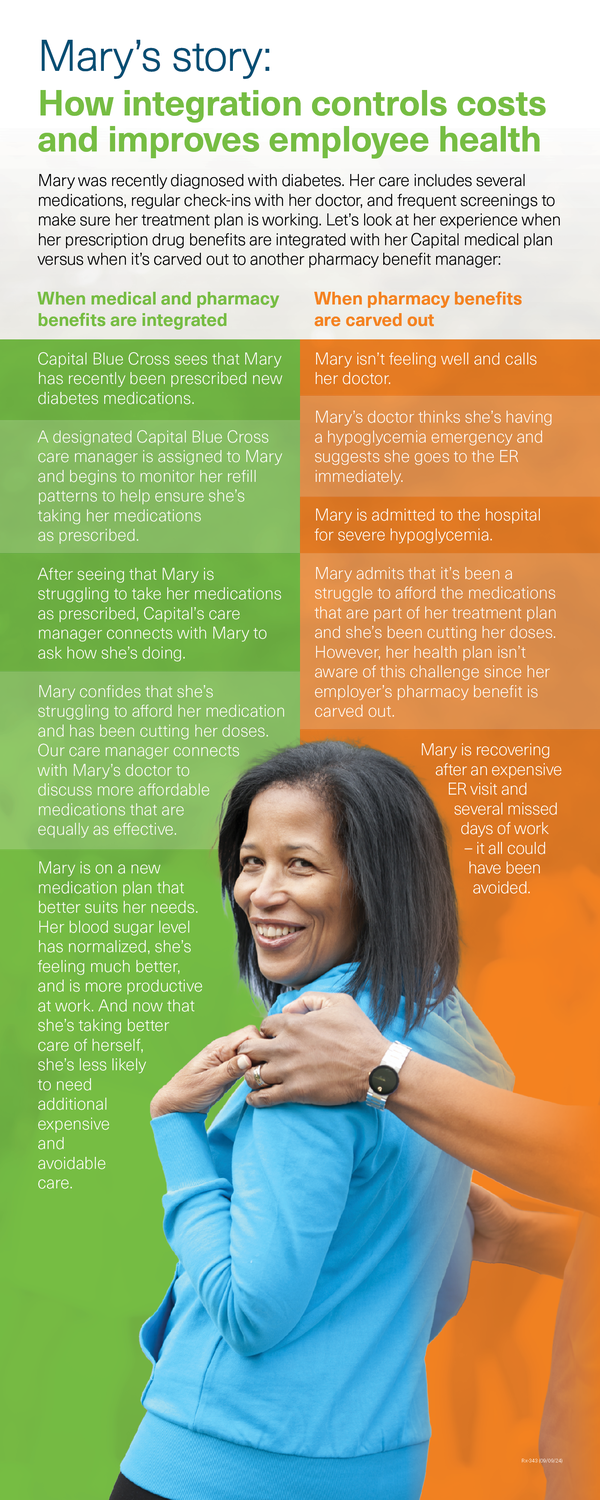By Capital Blue Cross – THINK (Trusted Health Information, News, and Knowledge) is a community publication of Capital Blue Cross. Our mission is to provide education, resources, and news on the latest health and insurance issues.
While employers have little control over the rising costs of medications, they can adopt cost-effective strategies to help ensure their employees are getting the right medications at a more affordable cost and get the support they need to best manage chronic health conditions.
When it comes to containing healthcare costs, employers face a number of challenges – and prescription drug management is at the root of several of them.
For starters, nearly half of Americans routinely take a prescription medication and a quarter of Americans are on three or more prescribed drugs, according to the Centers for Disease Control and Prevention (CDC). While these medications are beneficial for health, they take a financial toll on employees and employers alike: Nationwide spending on retail prescription drugs has steadily increased for decades, reaching $406 billion in 2022, according to the CDC.
Ironically, when people don’t take their medications, the cost impact can be nearly as burdensome, causing the need for more, often unavoidable care – up to $300 billion worth, according to the American College of Preventive Medicine.
While employers have little control over the rising costs of medications, they can adopt cost-effective strategies to help ensure their employees are getting the right medications at a more affordable cost and get the support they need to best manage chronic health conditions.
Your health insurer might be able to help
Capital Blue Cross is helping its employer groups collectively save millions of dollars annually with a simple solution: integrate prescription drug coverage and medical coverage into the same plan. The results? Having medical and drug coverage in one plan provides clear, actionable data employers can use to help keep their employees healthy, save money, and provide a more efficient experience.
Capital’s integration strategies have:
- Helped self-funded employers save an average of nearly $440 per member per year.
- Lowered emergency room visits by 15%.
- Reduced urgent care visits and inpatient visits by 9%.
In addition to cost savings and improved health outcomes, integrating medical and drug coverages can give your business:
Greater administrative efficiency
When your employees have a single system for enrolling in both types of coverage, it saves time and paperwork. Members also have the ease of using a single ID card for both medical and drug coverage.
More meaningful insights
Data drives smart business decisions, and integrating coverage allows you to more easily see how much, how often, and why certain drugs are prescribed. This helps you manage rising costs, and better care for your employees.
Better care for your employees
Integration means Capital and doctors can access real-time information about a member’s pharmacy benefit to consider available drug options and compare out-of-pocket drug costs before writing a prescription.
Together with our pharmacy benefit manager, Capital Blue Cross goes the extra mile when you combine medical and prescription drug coverage, offering additional tools and resources to help control costs and improve health outcomes.
Capital Blue Cross offers a free service for members that helps close gaps in care and reduces the risk of members forgetting to take their medications, leading to improved outcomes and lower total cost of care. Another service uses data to manage members’ medications and address the most viable therapeutic opportunities, helping to drive cost savings for employers, while ensuring members receive the most effective medications.
In addition, Capital gives employers access to our interactive data dashboard, which captures pharmacy and medical data that can identify cost-saving opportunities over time.
Integrating your medical and drug coverage into one plan is good for your employees and your business. It helps you control costs while improving the health outcomes of your employees. If your benefits consultant has asked you to consider separating your prescription drug and medical coverage, ask them why and encourage them to review our study.
You can find more useful articles at https://thinkcapitalbluecross.com/
Information provided to TVL by:
JERRY REIMENSCHNEIDER
Senior Public Relations Specialist | Brand & Market Strategy
https://www.capbluecross.com/






